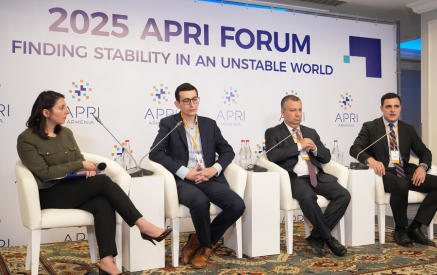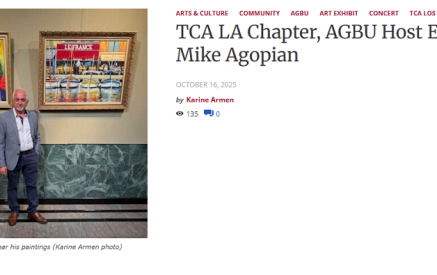“Armenia is full of art.” says Shoghakat Mlke-Galstyan. In every family there is someone who paints, plays, sings… When an Armenian speaks about Armenia, the second or third word is about art.” And yet, the arts are among the least studied fields, and artists face constant challenges and issues that distract them from their creativity, suppressing the potential of the field.
Shoghakat Mlke-Galstyan is the Communications and Events Coordinator of the Katapult Creative Accelerator Programme, a three-year EU-funded initiative that aims to overcome some of these challenges.
The programme was launched in April 2022, at the initiative of the Armenian General Benevolent Union (AGBU) and the Creative Armenia Arts Foundation with the aim of empowering artists and promoting the ecosystem of cultural and creative industries. It has a total budget of €3,750,000, of which €750,000 comes from the AGBU, while the main donor is the European Union.
When the artist meets the market…
Read also
One of the components of the Katapult Creative Accelerator Programme is to offer the artist financial stability and empowerment. Shoghakat Mlke-Galstyan explains what this means and why it is important.
“The identity of the artist is threatened when dealing with the market, and this is a serious issue in Armenia. For example, an artist wants to make money, which is great, but there are very few opportunities to make money doing exactly what they want to do. More often than not, they have to adapt their styles to the market. We all know what that means, what kind of songs are in demand in restaurants, what works of art hang in houses, etc… And here we understand that the artist has a fragile personality; after several such orders it seems to them that they have betrayed their identity, which is why they say: the market is a bad thing, I need to stay away from it… There are many cases when an artist works as a trader, teacher, or does various administrative tasks, but does not allow the market to touch his art,” says Shoghakat and adds: “The vision of Katapult is that the artist is not in a financial, but in a creative search.” But how?
From individual solutions to systemic improvements
Observations of international and local trends, study of curricula, focus group discussions, telephone and Internet surveys, and economic analysis preceded the launch of the Katapult Creative Accelerator Programme to somehow illustrate the issues of the cultural industry.
The first issue that greatly harms creative people is the infringement of intellectual property rights. Shoghakat Mlke-Galstyan is certain that in Armenia copyright is violated in 90 percent of cases, and royalties are extremely low. The first Global Intellectual Property Forum, held on April 29, 2023, was aimed at addressing this issue. The Forum and other similar events, seminars, and training sessions are at the heart of the Katapult Programme.
Another challenge for the creative industry is the regulation of online shopping. In the case when the state does not see how much money art brings in, that is, when the real potential of the creative industry is not reflected in GDP, there is little incentive to implement reforms. Why focus on an industry that generates very little turnover? According to Shoghakat, there are no relevant payment systems in operation in Armenia, legal solutions have not yet been found, and online sales are often carried out illegally. “Let’s say you liked something on Instagram and bought it; you most likely set up an Idram account, card number and were asked to make a transfer. You liked the purchase, everything was very nice, but it was an illegal transaction, since you were not provided with a receipt for the purchase. But if the artist decides to make the process completely legal, he must issue you an online invoice, and you will be required to provide passport data… Imagine that you are buying a small toy for your child worth 5000 AMD, and you are asked for passport details. Would you go through with the transaction?”
Shoghakat says that in order to make it easy and convenient for artists to enter the market legally, and ensure that they are protected, strategic approaches must be developed, because “no one in the world, be it a German or an American, likes to pay taxes”. “If I tell an artist that you have to register 5,000 dolls you have made, he will ask me why should I register this if I live well and do not pay taxes. And this is an important question. There are different models in the world that provide an answer to this question, for example, in the German model, the more professional expenses an artist reports about, the less tax he pays,” says Shoghakat Mlke-Galstyan.
The third major issue in the creative industry is the complexity of transportation. The fact is that before the goods can be produced and dispatched to the customer, the artist still needs to obtain materials. There are many great and small issues in this supply chain, the sector is not coordinated, or even if it is coordinated, people in the same sector often have conflicting information on the same issue.
Shoghakat Mlke-Galstyan, the Communications and Events Coordinator of the Katapult Creative Accelerator Programme, emphasises that not a single solution found by the artist is wrong. It’s just that these decisions are unique to the individual, and this greatly hinders the industry. “Our only goal is to see how you found individual solutions, whether they can be adapted to the system, so that we have systematic solutions. We aim to avoid situations where problems are solved only by the strong, courageous and resourceful, and to promote the system as a whole to support the artist.”
Collaboration
The launch of the ‘Katapult’ programme was marked by the signing of a Memorandum of Understanding between the AGBU, the EU, the Ministry of Education, Science, Culture and Sports, the Ministry of Economy and the Ministry of High-Tech Industry of Armenia. The MoU is based on the school of thought that universal changes should be tangible and can only be achieved as a result of joint efforts. According to Shoghakat Mlke-Galstyan, “We want to carry out serious reforms, but the sector is not ready for fundamental changes, we are not ready, the country is not ready, and small changes are often more feasible. For example, there are many unregistered individual artists; freelance artists are a very big driving force in the field of culture, but we do not have the term “freelance artist” in the legal field. During COVID, we realised that they were simply ignored by all programmes.”
Varvara Hovhannisyan, adviser at Ministry of Economy, says she takes pleasure in being part of the discussions with “Кatapult”. She highlights the work done in the focus groups and emphasises that the transparency of the AGBU lays the foundations for effective development. Svetlana Sahakyan, Head of the Contemporary Art Department of the RA Ministry of Education, Science, Culture and Sports, also said that in the first year of Katapult, a lot had been achieved, i.e. a database of active figures and organisations in the field was created, for which workshops and discussions were regularly organised, a forum on copyright was set up, collaborations and networks were established with filmmakers and film producers, and the most successful initiative of the programme was the Katapult expo.
Katapult Pavilion
Visiting Katapult’s creative industry expo in late April, towards the end of its month-long residence at the HayArt cultural centre in Yerevan, the venue wasn’t crowded, allowing visitors to take their time in inspecting the exhibits. According to those working there, the first weeks of the expo were much more crowded, with the most popular exhibit being was the fashion capsule, which also generated the most sales.
At the Printing and Books sub-booth, Albert Avagyan explained that some of the samples selected for the exhibition were either not for sale or had limited copies, which makes the stand more interesting. Albert added that, in addition to the Katapult, the HayArt building itself was also a discovery for many visitors. “The round building on Mashtots Avenue is very well known, but some visitors had never seen it from the inside; the building was also interesting for guests from other countries. We were visited by embassies, delegations, the Mayor of Lyon, students, artists, passers-by… The Katapult Pavilion was a good opportunity for both authors and publishers. We have books that are truly unique – you won’t find them anywhere else. For example, we have silk-screen prints of Dadivank that were made shortly after the war. Look, at the very end there is a part of the imprint on clay. It is interesting that each copy is different, this book has historical and cultural value,” says Albert.
Another particularly impressive booth was the creative technology capsule presented by :DDD Kunst House. This is a unique exhibition that explores how technology is slowly erasing the human presence through applied art and installations. The capsule featured two apps and one installation: Damyansky’s Goodbye Camera, a post-human camera that removes a person from an image, Nare Petrosyan’s How to be an Artist app, which allows anyone to become an artist, and Sasun Margaryan’s Beyond Online interactive installation on the importance and fragility of physical interventions.
Curator Teresa Davtyan said that her motivation for participating in the Katapult creative industry expo was that she recently began to actively study technological art, build relationships with artists who have extensive experience in this field, and intends to undertake steps to try and create a bridge between local and international artists for exchange. “It’s strange to sell your work, but it’s the only way to be independent…” Teresa quotes the artist Raphael Roosendaal and adds: “The Katapult creative industry expo, one of the goals of which is to create opportunities for the sale of works of art themselves, was an important professional experience for me and the artists I chose to show.” Teresa says that there are many obstacles in the field of contemporary art and art in general, but she tries not to lose the artist’s “pure joy” in these difficulties and has always sought and found the way of free and healthy cooperation that she imagined.
Author: Armine Hovhannisyan





























































